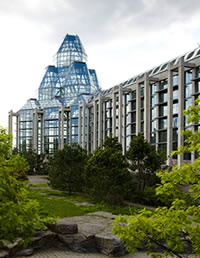The exhibition Global Citizen: The Architecture of Moshe Safdie explores Moshe Safdie’s structures and the philosophy that shapes them through approximately 175 drawings, sketches, videos, photographs and scale models. Open through 9 January 2011.
Discover how the world-renowned Israeli-born architect, who has studied in Montreal, has conceived impressive buildings and avant-garde communities in Canada, the United States and across the world.
 His use of transcendent light, powerful geometry and iconic forms is recognizable in buildings such as the National Gallery of Canada (Ottawa), Habitat 67 (Montreal), the United States Institute of Peace Headquarters (Washington, DC), Crystal Bridges Museum of American Art (Arkansas), Mamilla Center (Jerusalem), the Khalsa Heritage Centre (India) and Marina Bay Sands (Singapore).
His use of transcendent light, powerful geometry and iconic forms is recognizable in buildings such as the National Gallery of Canada (Ottawa), Habitat 67 (Montreal), the United States Institute of Peace Headquarters (Washington, DC), Crystal Bridges Museum of American Art (Arkansas), Mamilla Center (Jerusalem), the Khalsa Heritage Centre (India) and Marina Bay Sands (Singapore).
Organized by the Crystal Bridges Museum of American Art, Bentonville, Arkansas, and the Skirball Cultural Center, Los Angeles.
Global Citizen explores the design and building process of Moshe Safdie’s projects in Jerusalem, North America, China, Singapore, and India. It makes its only Canadian stop at the National Gallery of Canada in Ottawa, a fitting start, since the Gallery project was a booster stage in his own career in the 1980’s. Into this space, that Safdie himself designed, will come his sketches, building mock-ups, photographs and newly commissioned films of 30 building projects.
The exhibition underscores his deep impact on architectural practices and the realization of his design philosophy and is divided into five sections, each dedicated to pivotal points of development in Safdie’s design philosophy, termed “progressive contextualism.” The first fittingly centres on Habitat, followed by an area concentrating on his work in Israel. Section three, showcasing his North American works, begins naturally with the Gallery.
The next part takes him, and his three passports (Canadian, American and Israeli), global, with commissions west and east. The exhibition’s concluding section is titled Habitat of the Future, and is an evolutionary reworking of Habitat–Safdie’s radical solution for quality, affordable housing, that includes models and a film.
Moshe Safdie is a leading architect, urban planner, theorist, educator, and author. Embracing a comprehensive and humane design philosophy, Safdie has been a visionary force in architecture and urban planning and design for over forty years. He is committed to architecture that supports and enhances a project’s program; that is informed by the geographic, social, and cultural elements that define a place; and that responds to human needs and aspirations.
Born in Haifa, Israel, in 1938, Moshe Safdie moved to Canada with his family at age 15. He graduated from McGill University in 1961 with a degree in architecture. After apprenticing with Louis I. Kahn in Philadelphia, Safdie returned to Montreal to oversee the master plan for the 1967 World Exhibition and realized Habitat ’67, an adaptation of his thesis at McGill; this central feature of the World’s Fair became a pioneering example of prefabricated housing and launched the 29-year-old Safdie on his illustrious career.
In 1970, Safdie established a Jerusalem branch office and was responsible for major segments of the restoration of the Old City of Jerusalem and, over the years, the new city of Modi’in, the new Yad Vashem Holocaust Museum and the Rabin Memorial Center. During this period, Safdie also became involved in the developing world, working in Senegal, Iran and Singapore.
Over the years, Safdie has completed a wide range of projects, including cultural, educational, and civic institutions; neighborhoods and public parks; mixed-use urban centers and airports; and master plans for existing communities and entirely new cities.
In Canada, he has left his mark in Quebec City (Musée de la civilisation), Montreal (Montreal Museum of Fine Arts), Ottawa (National Gallery of Canada and City Hall), Toronto (Pearson International Airport) and Vancouver (Library Square).
Safdie currently has major projects under construction in the U.S., Jerusalem, and India. His residence and principal office are located in Boston, Massachusetts.
Image: National Gallery of Canada
www.gallery.ca